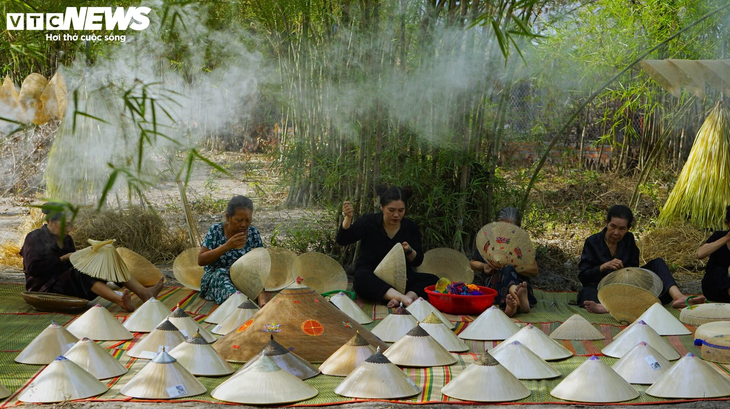The conical hat of Phu Gia village in Phu Cat district, Binh Dinh province, has been called a "masterpiece". This unique handicraft product bears the cultural and historical identity of King Quang Trung’s reign. The time-honored craft was recently recognized as a National Intangible Cultural Heritage by the Ministry of Culture, Sports, and Tourism.

Ceremony of receiving the “National Intangible Cultural Heritage” title for Phu Gia conical hat craft village (Photo: VTC)
Located about 35km from the center of Quy Nhon city, 300-year-old Phu Gia village is known for its craft of making “horse” conical hats, once an indispensable accessory of court officials. Phu Gia conical hats symbolize the strength and majesty of military mandarins of the Tay Son uprising army.
The Phu Gia “horse” hat is a unique product. According to village elders, its name comes from the fact that the hat is as durable as a horse. At one time, only royalty and the rich had the right to wear a horse conical hat. In the feudal era, mandarins and landlords had the right to wear the hats with a silver-peaked cap decorated with a dragon and a phoenix to show their authority.
Phu Gia hats are famous for their sophisticated embroidered apricot, orchid, chrysanthemum, and bamboo patterns corresponding to the position and rank of the wearer.
Do Van Lan, who has been making hats for more than 6 decades, said, “It’s very difficult to make horse hats. It requires 10 steps. Each step must be completely manual. The most difficult step is embroidering a unique pattern.”
Phu Gia village has 110 households engaged in the craft. Their 300 workers produce 3,300 hats a year.

Phu Gia conical hat craft village has 110 households engaged in the craft, making 3,300 items each year. (Photo: VTC)
Each horse hat is carefully made and involves creating the rib, embroidering patterns on the ribs, and roofing. Each village or hamlet specializes in one stage. A typical hat costs 12 to 20 USD, but an elaborate hat that takes a whole month to complete could cost more than 100 dollars.
Huynh Thi Hong, a villager, told that everyone loves the craft because it used to employ the whole family, and paid for the children’s study.
Local artisans have created more modern styles of hats, which have become popular as souvenirs sold to tourists who come to Binh Dinh. Phu Gia horse conical hats are now available throughout Vietnam and exported to other countries. The village has become a highlight of Binh Dinh province tours.
A villager named Lan said, “Phu Gia villagers are very happy that our craft is now a national intangible cultural heritage. This motivates my family and the others to create more beautiful hats to promote our traditional craft.”
Lam Hai Giang, Deputy Chairman of the provincial People's Committee, said Phu Cat district and Binh Dinh province will issue a detailed plan to link the preservation of the craft with tourism development.
“We’ll develop and implement solutions and policies to help artisans preserve and pass on their profession. Artisans should be considered national assets and receive appropriate support policies. And more activities should be organized to honor individuals and communities who contribute to preserving, protecting, and promoting this heritage,” said Giang.
Thanh Thang